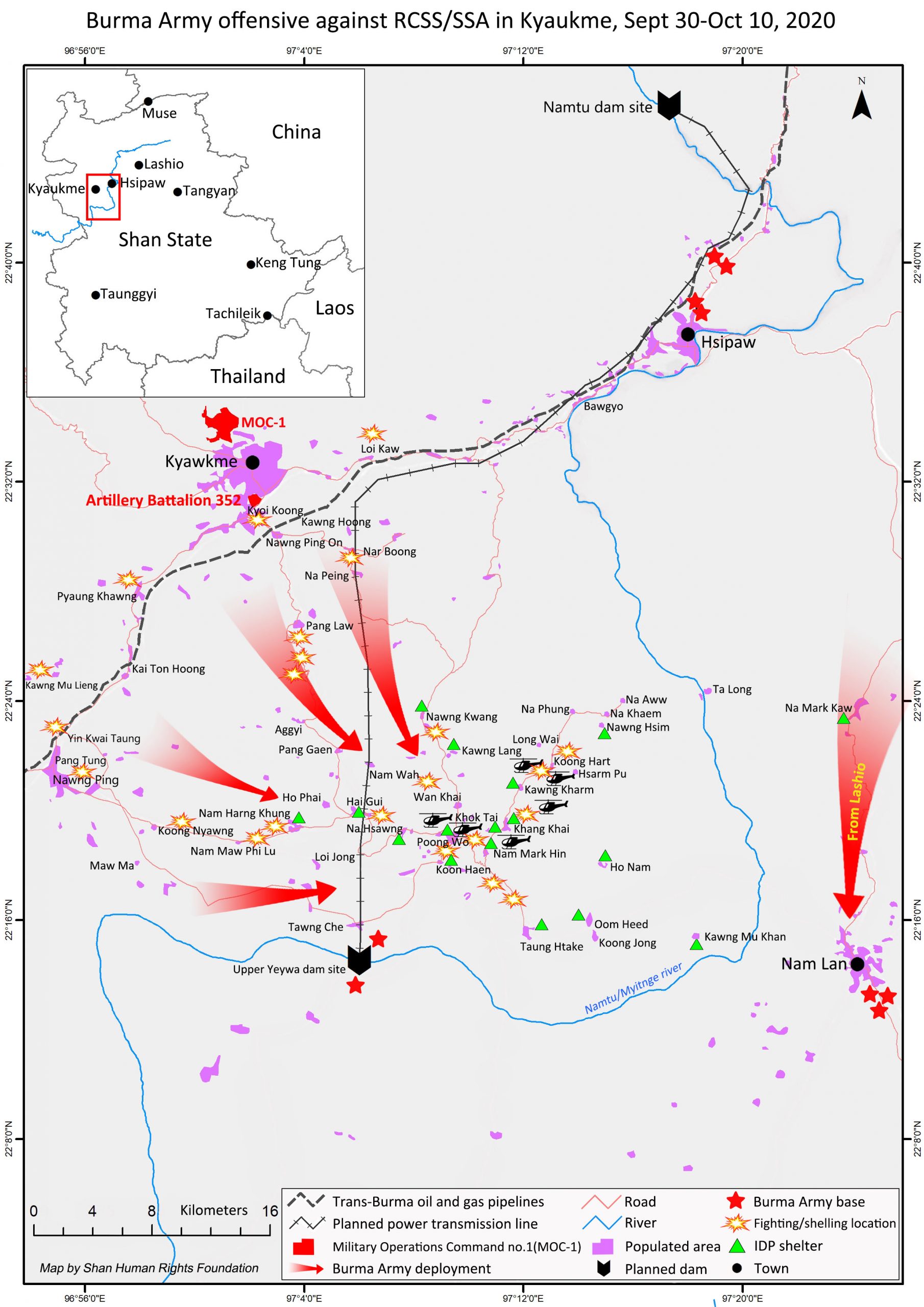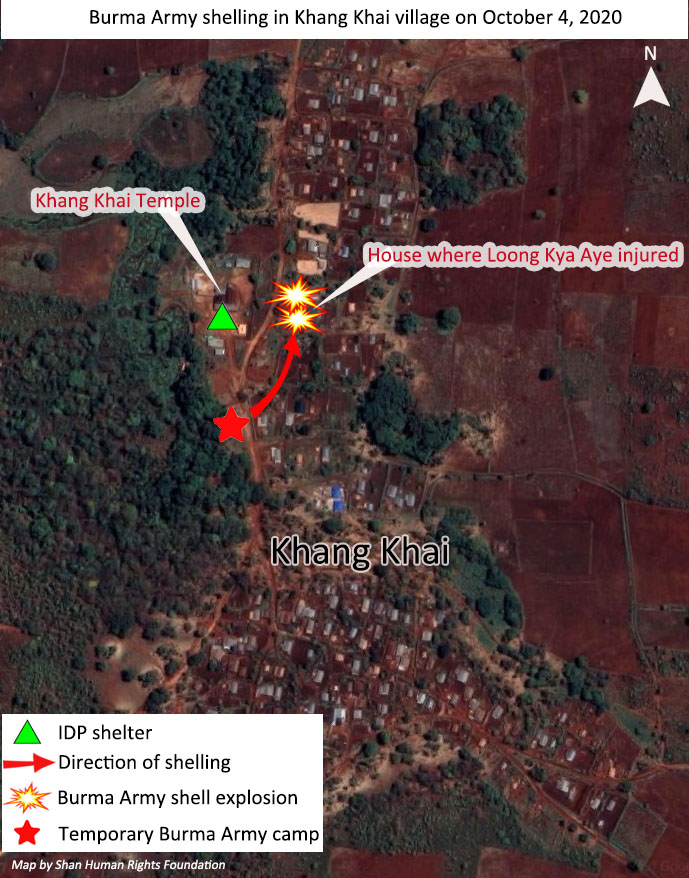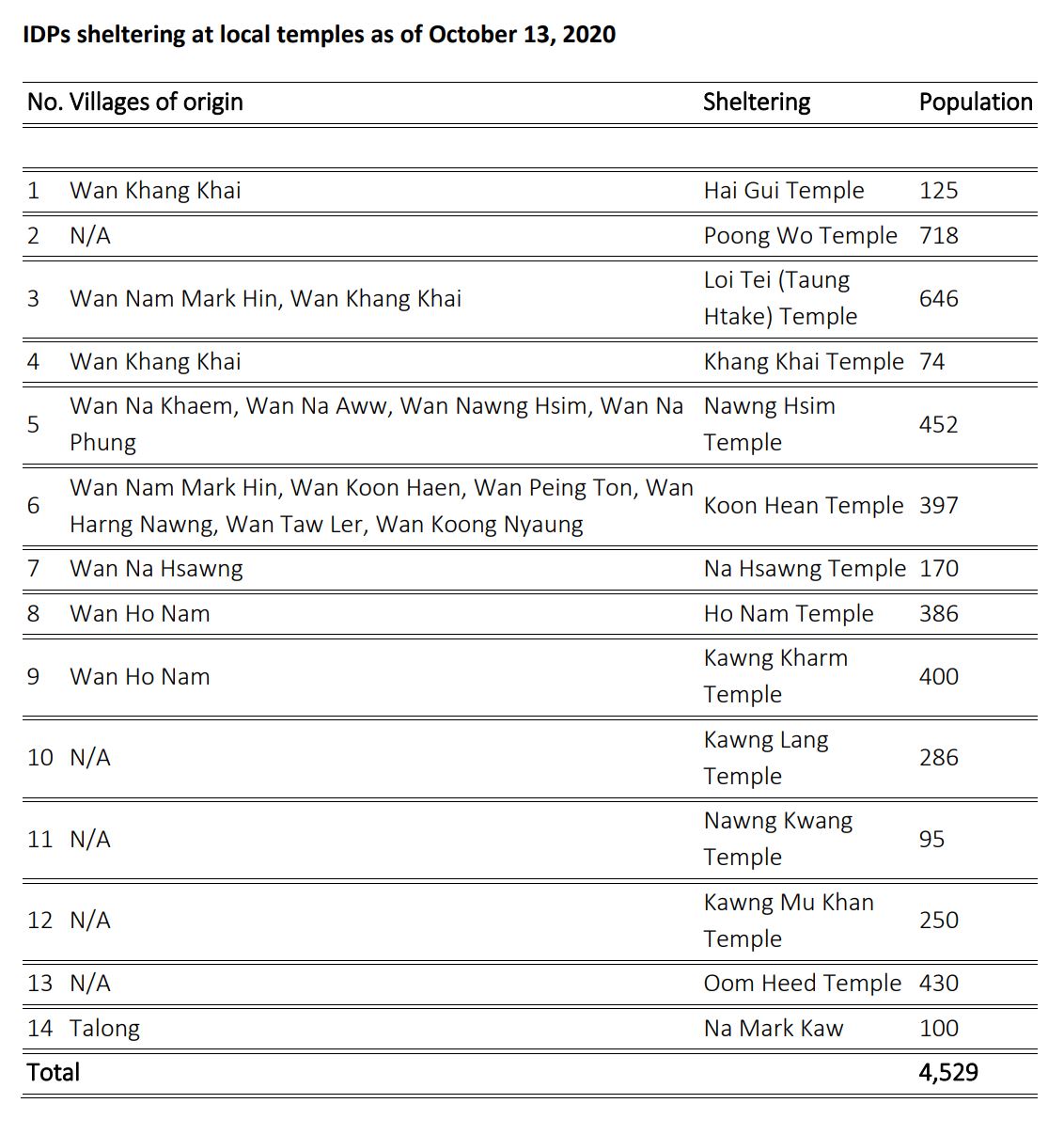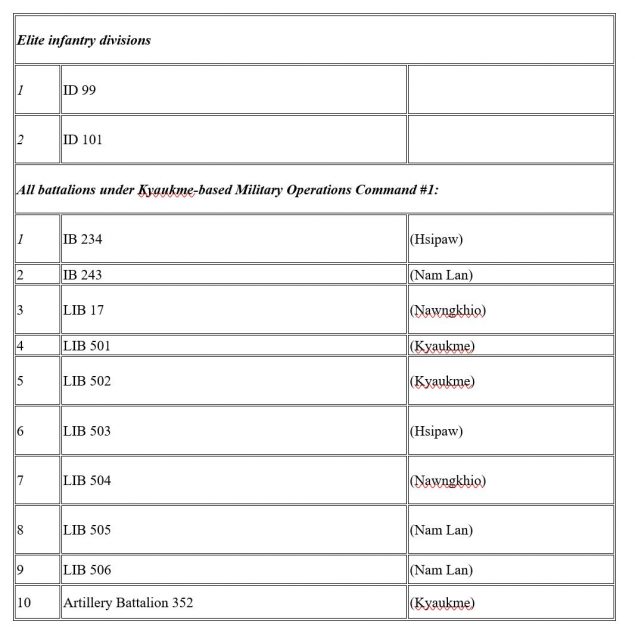Indiscriminate Shelling, Torture, Looting by Burma Army During Large-scale Offensive against RCSS/SSA in Southern Kyaukme

October 19, 2020
Since September 30, 2020, the Burma Army has been carrying out a large-scale ground and air offensive against the Restoration Council of Shan State/Shan State Army (RCSS/SSA) in southern Kyaukme township, committing flagrant abuses against civilians, including indiscriminate shelling, torture, looting and destruction of property.
Over 1,000 Burma Army troops, from Kyaukme-based Military Operations Command #1 and mobile combat divisions ID 101 and ID 99, backed by helicopter gunships, have been sweeping through villages south of Kyaukme town, firing indiscriminately, and causing over 4,500 villagers to flee from their homes.
Burma Army abuses documented in detail by SHRF include: indiscriminate shelling in Khang Khai village, seriously injuring a 45-year-old villager; looting and destruction of property in Khang Khai and Nam Mark Hin villages; arbitrary arrest of two villagers in Nam Mark Hin village; torture and disappearance of a 19-year-old villager from Na Phung village.
The Burma Army is continuing to build up troops in the area, and forbidding villagers from returning home. The IDPs, crowded together in village temples, are facing food shortages, and fear exposure to Covid-19.
The offensive is in violation of the Nationwide Ceasefire Agreement (NCA), to which RCSS/SSA is a signatory, as well as the Burma Army’s recently extended unilateral ceasefire, declared to deal with the Covid-19 crisis. It is the second offensive launched by the Burma Army against the RCSS/SSA in southern Kyaukme this year. An earlier unprovoked offensive in June, involving extrajudicial killing and torture, led to a mass protest on July 10 by over 15,000 Kyaukme villagers.
The Burma Army alleges that fighting broke out because RCSS/SSA is operating outside boundaries agreed upon under the NCA, but the RCSS/SSA has pointed out that no such boundaries have been agreed upon.
On October 10, the Burma Army True News Information Team defended the operation by saying its troops were providing “security” along the Mandalay-Lashio highway. This highlights a likely main reason for the offensive: to secure new infrastructure development in Kyaukme, including expansion of the China Myanmar Economic Corridor, and construction of new power transmission lines between planned dams along the Namtu/Myitnge river. Surveying for the 230 kV power lines, stretching 75 kms from the Upper Yeywa dam site to the Namtu dam site in Hsipaw, has recently started.
Locals also suspect that the Burma Army has deliberately sparked fighting to disrupt voting in the November 8 general election in Kyaukme, where the Shan Nationalities League for Democracy (SNLD) won all seats in the 2015 election (in the Upper and Lower Houses, as well as the State Parliament). On October 16, 2020, the Union Election Commission announced that voting would be cancelled in 12 village tracts in Kyaukme, including four tracts in southern Kyaukme: Nawng Hsim, Pang Law, Hai Gui and Kher Nim.
SHRF strongly condemns this unprovoked offensive, and demands that the Burma Army immediately withdraw troops from villages in southern Kyaukme, so that villagers can return home. We call urgently for international pressure to bring an end to Burma Army offensives and human rights violations throughout the country, so that inclusive negotiations towards a new federal constitution can begin.
We also reiterate our demands to foreign companies to pull out from the Upper Yeywa hydropower dam project, to avoid complicity in atrocities by Burma Army troops securing the site.

Details of human rights violations by the Burma Army
Indiscriminate shelling causing civilian injury; looting and destruction of property in Khang Khai village
On October 3, 2020, about 50 Burma Army troops entered Khang Khai village, where most villagers had taken shelter in the village temple, due to the fighting around the area. The troops stationed themselves around the village, and some camped in the temple.
A local teacher called Nang Kham Noom and her husband had decided to stay in their house, with a hired worker, Loong Kya Aye, age 45, (son of Loong Maung Herng and Ba Sue) as they wanted to guard their possessions.
On October 4, at 6 pm, Burma Army troops stationed on a hillock south of the temple, fired shells directly into the village. Two shells landed on Nang Kham Noom’s house, damaging the building, and injuring Loong Kya Aye, who was hit by shrapnel in the left ear, hand, waist and leg. Another shell landed in the same compound, damaging a tractor.

Nang Kham Noom did not dare leave the house. She phoned to the abbot at the Khang Khai temple, begging him to come and help. He said the Burma Army did not allow him to leave the temple, but he would talk to them. After a while, three elderly villagers came with four Burma Army soldiers to carry Loong Kya Aye to the temple, where his wounds were washed. He was taken by truck to Kyaukme hospital at 9 pm for emergency treatment.
The Burma Army soldiers removed the tail sections of the two mortar shells which had hit the house, and told villagers that they were not Burma Army shells, but belonged to RCSS/SSA. However, the fragments were clearly identifiable as 60 mm shells, commonly used by the Burma Army.
The Burma Army troops did not allow Nang Kham Noom back into her house after the shelling. Villagers in the temple saw the troops looting food and possessions from her house, and then breaking down the entire building. The troops also ransacked other houses, destroying food supplies.
According to one villager: “At night, they entered the village again searching and eating up all the food. They emptied out (remaining) rice and poured out cooking oil. They put our mattresses outside in the middle of the village. They searched and ransacked all the houses in the village.”
After pictures and news of Loong Kya Aye’s injuries were spread on social media, the Burma Army True News Information Team released a statement on October 6, blaming the RCSS/SSA for the shelling.
The statement read: “In the evening of October 4, close to Khang Khai village, a Tatmadaw column securing the area fought with a group of RCSS/SSA, who were operating outside their designated area. In the fighting, about 3,000 meters east of Khang Khai village, the RCSS/SSA fired shells which landed and exploded in Khang Khai village, injuring U Kya Aye, who was staying in the house of Daw Kham Noom.”
Two villagers arrested and tied up; looting and destruction of property in Nam Mark Hin village
On October 4, Burma Army troops shot dead a buffalo in Nam Mark Hin village. When villagers saw this, they tried to round up their buffalo and take them to their houses for protection. Two male villagers, Loong Khen and Loong Yong, were in the process of rounding up their buffalo, when some Burma Army soldiers staying in the village pointed their guns at them, and ordered them to come to a house where their commander was staying in the west of the village.
One of the arrested villagers described what happened: “We told them that we were villagers from this village, and just civilians. We begged them not to do anything to us. But they tied our hands behind our back, and tied us to a house pole under a house.”
Luckily, the two villagers managed to untie themselves that night and escape under cover of darkness to a nearby village.
The same villager said: “The Burmese soldiers also shot dead two pigs and searched all the houses in the village. They took all the money they found. They also opened children’s school bags, and seeing English lesson books, they asked us: ‘Who came and taught you English?’ We told them that our abbot at Poong Wo temple taught our children. Then they said, ‘If so, the abbot of Poong Wo is an insurgent abbot, right?’ Burmese soldiers have dug holes around houses in our village. They are staying in our house compounds and under our houses, and shooting from there.”
Another woman who fled from Nam Mark Hin said: “We worry about our livestock. Our village is becoming a Burmese troop base. When they started fighting, they stayed at the edge of our mother’s house fence, then moved to her cow-stall, and shot from there. Then they moved to under our house and shot from there. They shoot from every house they stay in. That’s why we were afraid and fled. We couldn’t call anyone to accompany us. We just rushed to flee.”
There are about 35 households in Nam Mark Hin. All the inhabitants fled on October 4, except for seven villagers (five men and two women), who were forbidden by the Burma Army troops from leaving the village. They were forced to stay in one of the houses, guarded by Burma Army troops, until October 11, when 2 SNLD MPs, Sai Tun Win and Lung Sai Ku, and members of the Nam Khong welfare group arrived at Nam Mark Hin, and negotiated with the local Burma Army commander for their release. They then brought them to Taung Htake temple, to shelter with other IDPs.
Since October 11, Nam Mark Hin has remained deserted. The Burma Army has looted and destroyed property in all the houses, slashing rice sacks, dismantling bamboo floors, and throwing bedding outside to be spoiled in the rain. Villagers tried to return to Nam Mark Hin on October 12, but were blocked by the Burma Army patrolling in the area.
Villager disappears after being tortured on suspicion of being Shan soldier
On October 9, at about 4:30 pm, Sai Maung Oo, a 19-year-old farmer from Na Phung village, left his house to tend his farmland. On the way, he encountered Burma Army soldiers north of his village. The soldiers interrogated him, and searched his bag and pockets. They checked his mobile phone, and, finding a picture of him wearing camouflaged clothes, accused him of being a Shan soldier. He replied that he was not a soldier, and had just put on the clothes to take the photo.
Burmese soldiers said they did not believe him, and started kicking his face and body. They took him back to his house, which they searched and ransacked. They also looted food from the house. They then took Sai Maung Oo with them to Nawng Hsim village, where they stayed for one night. Local villagers and monks went to the soldiers to try and persuade them to release Sai Maung Oo, saying he was just an ordinary villager and not a soldier. The Burma Army troops replied they would not harm him and had just taken him to guide them.
On October 10 at 7 am, the Burma Army soldiers took him back to Na Phung village, and searched his house again. Then they took him with them to Hsarm Pu village for one night. No one has seen him since.
On October 14, the Burma Army troops informed the Na Phung village headman that Sai Maung Oo had run away from them. Locals fear he may have been killed.
Sai Maung Oo is the son of Loong Pancitta and Pa Hla Sey of Na Phung village.
Burma Army offensive to secure new power transmission lines?
Planned power transmission lines linking the Upper Yeywa dam-site to the planned Namtu dam in Hsipaw run across southern Kyaukme township, precisely where the current Burma Army offensive is taking place.
An impact assessment for these 230 kiloVolt lines has recently begun by Resource and Environment Myanmar Company Ltd (REM), commissioned by Natural Current Energy Hydropwer Co. Ltd. (NCEH), the project holder of the Namtu dam.
The 210 megawatt Namtu dam project is being planned on the Namtu/Myitnge river, about 25 kilometers north of Hsipaw town. Impact assessments are still being conducted for the Namtu dam, but since 2017, NCEH has been clearing protected forest, building roads to the dam site, and constructing rows of concrete workers’ housing. Namtu MP Nang Kham Aye has raised questions in the Naypyidaw parliament about this issue, but no action has been taken against NCEH.
Local communities are strongly opposed to the Namtu dam. The dam’s reservoir will stretch over 15 kilometers upstream, and will submerge the Shan village of Li Lu, with 47 households and 212 people. The villagers do not want to move. Thousands of Hsipaw villagers living downstream of the planned Namtu dam fear reduced water flow, unpredictable river fluctuations, and blocking of fertile sediment.
For further detail on the Namtu dam, see https://shanhumanrights.org/eng/index.php/387-unauthorized-construction-at-namtu-hsipaw-dam-site-highlights-urgent-need-for-dam-moratorium-in-burma


Timeline of Burma Army offensive against RCSS/SSA in southern Kyaukme township (Sept 30-Oct 10, 2020)
Timeline of Burma Army offensive against RCSS/SSA in southern Kyaukme township (Sept 30-Oct 10, 2020)
Burma Army battalions deployed:




Contact
Sai Hor Hseng +66: 94-728-6696 (Shan, English)
Sai Yord Leun +66: 97-173-1530 (Shan, Burmese)
Download PDF in English, Burmese and Shan.
၎
င
၎
၎
၎
င
၎
၎
၎
င
၎
၎

